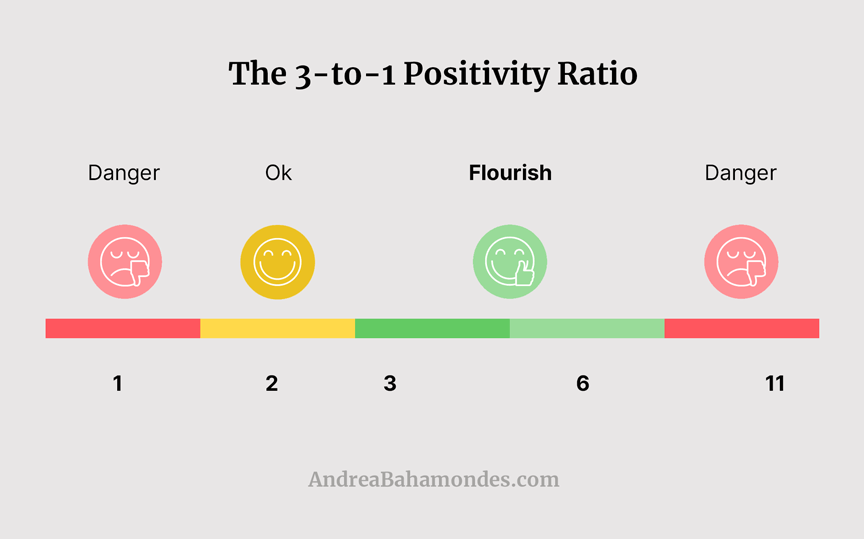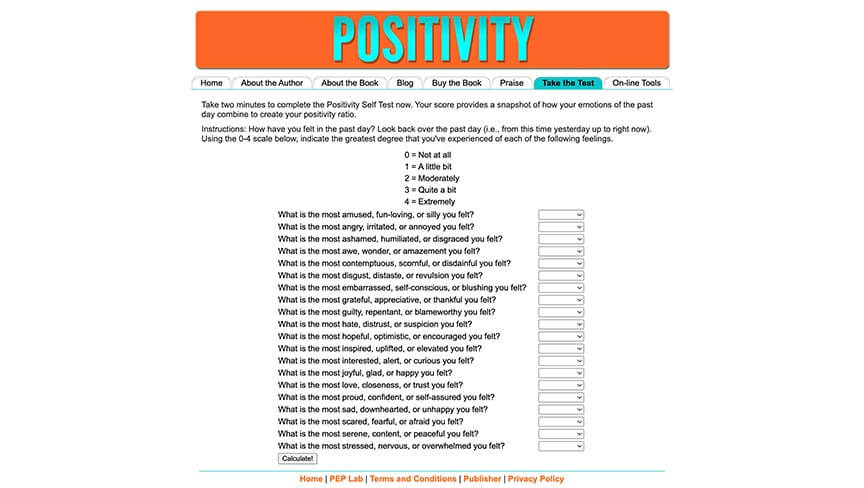Comedian and podcaster Marc Maron tells a story I love, about how everybody in the audience was laughing, except for one guy, who at that point becomes his sole focus for the rest of the show.
Sound familiar?
This is actually more common than we all think.
But, why does this happen? Why do we get stuck on the only negative detail and ignore the rest?
What is “Negativity Bias” and how it works
“Your brain is like Velcro for negative experiences and Teflon for positive ones.” —Rick Hanson
Yup, I’m starting a post about the 3-to-1 Positivity Ratio, talking about negativity. But, stay with me, I promise you I’ll turn it around in a minute.
We tend to focus more on negative than positive experiences, thoughts, and emotions than positive ones. We also remember them more vividly, in more detail, and for longer periods of time.
For example, just how quickly you might brush off a compliment someone gives you but will hold on to anything negative that can very easily ruin your entire day. And does.
Negativity sticks more than positivity.
The impact of Negative Bias in your life
While you’re busy with negative emotions, you struggle more and more to see the positive in your life. This has a significant impact, creating more stress, anxiety, depression and even affecting your relationships.
But there is more…
Remember Neuroplasticity? Yes, this can mean some serious rewiring in your brain. Not exactly the good kind.
So, the answer is crystal clear: Eliminate negativity!
Not so fast…
Negativity is still necessary [And why the “Be Positive” model is broken]
You need to be able to acknowledge and process negative emotions like sadness, frustration, and anger because these emotions are still part of the human experience.
Negativity bias is a necessary survival mechanism.
For example, a feeling of sadness or anxiety can help you connect with others.
A negative emotion can be the red flag you need to make a change. But first, you must give yourself permission to feel them as they arise.
This is why just “Be Positive” doesn’t really work, even though it sounds obvious. When you suppress negative emotions, you might be giving them a longer and stronger life.
And you do NOT want to give it more power.
Negativity can work for you
Please don’t say…
Balance!

The key is to find a healthy balance between positive and negative emotions.
Stop trying to live in a constant state of happiness, instead aim for emotional resilience and flexibility.
Negativity works for you, not against you when you’re able to process both positive and negative emotions in a healthy way.
Also, not getting stuck in either one for too long is kind of important.
Why you need positivity in your life (The benefits of Positivity)
Enough negativity already, let’s move on to the light now…
We’ve established that negativity is a necessary evil in your life, and we mentioned that it needs to be carefully controlled. The best way to do this is with a counterattack:
Say hello to Positivity. 🤗
With its wide range of benefits like:
- Better mood
- Stronger immune system
- Enhanced creativity
- Healthier relationships
And an overall feeling of well-being, obviously.
The 3-to-1 Positivity Ratio [How much positivity do you need?]
So, you don’t want to be labeled as a “negative person” among your friends or coworkers, but fueling on toxic motivation sounds as bad, if not worse.
The good thing is, there is a formula, and there are strategies and exercises to reach this elusive balance between heaven and hell, we’ll cover everything you need to know below.
What is the “3-to-1 Positivity Ratio” and how it works

The Positivity Ratio is a concept introduced by psychologist Barbara Fredrickson in her book “Positivity: Top-Notch Research Reveals the 3-to-1 Ratio That Will Change Your Life.“
Essentially, it refers to the idea of keeping a ratio between positive and negative experiences, emotions, and thoughts in your life to achieve the desired outcome.
If you’re asking yourself just how much positivity you need in your life, the answer is that to flourish, you’d need at least 3 positive emotions for every negative emotion.
3 Positives = 1 Negative
Don’t forget the negativity bias we discussed before.
But, what happens above or below that ratio?

The 3-to-1 Ratio is known as the Tipping Point. Below that point, people languish. Above, people flourish.
In other words, the Tipping Point is where you begin to thrive. You’re also better at coping with stress and anxiety, solving problems, and finding the meaningful and positive things in life.
Below the Tipping Point, you’ll find yourself in the “Languish Zone,” where the bad wolf lives.
The “Flourish Zone” on the other hand, is where you set yourself up for success, a good fulfilling life full of creativity and a sense of purpose.
How to raise the Positivity Ratio in your everyday life
According to the research, only 20% of us manage to thrive.
So, how can you generate, maintain, and reinforce all that positivity? In your life. On the daily.
Now it is starting to sound a bit more complicated.
Dr. Fredrickson suggests five qualities to trigger more positive experiences in your life: Be more open, appreciative, curious, kind, and real.
Let’s talk about some of the ways to increase that positivity ratio.
Practice Gratitude
You know this, right? Gratitude is one of the most effective ways to overcome negativity.
I actually believe that gratitude has an instant gratification feeling that is hard to match with any other emotion.
Gratitude allows you to focus on the positive aspects of your life, even when you face adversity.
I even have an exercise for you…
It’s called “Three Good Things” or “What Went Well” depending on where you land.
I love it, it’s very popular in the positive psychology world, it’s quick and easy, but the best part is the almost guaranteed instant gratification.
You don’t need anything, a few minutes for yourself at the end of your day, and something to write, you can download the exercise below, and you can also use a journal, but really, a napkin will totally do.
Cultivate positive relationships
Creating positive experiences is usually much easier when you surround yourself with positive people.
More importantly, having positive folks around you will help when you face adversity.
Take the time to observe your current relationships, and determine who makes it in the positive category and who doesn’t. Nurture your existing relationships and make new connections, now that you have the criteria in your pocket.
Go, spend time with people who share your values and lift you up!
Positive Self-Talk
Positive self-talk might seem a little silly for some people, but I think most of us are in constant conversation with ourselves.
Truth is that the way you speak to yourself affects your mood, one way or the other.
The key here is having the awareness to catch the negative self-talk in mid-air and replace it with positive affirmations.
This is important in both the short and long term. It has the power to modify your mood in the present moment and, even more importantly, it rewires your brain to focus on the good.
Reframing negative thoughts
In this case, you’ll start by identifying the negative thinking and self-talk that you engage in more frequently.
Some of this stuff might feel insignificant when you first think about it, but very simple comments like…
“I’m not good enough” or “I always mess things up”
Can, not only ruin the moment but rewire your brain in a negative way.
Once identified, challenge them!
You have evidence to prove the contrary.
these thoughts, challenge them with evidence to the contrary. You know your strengths and accomplishments, you were there.
Use the evidence!
For example, if you’re feeling like you’re not good enough, remind yourself of your strengths and accomplishments.
Mindful media consumption
“After a heavy movie, always watch an episode of Friends.” -My wife
I know, it’s hard to avoid the media, especially news bad news.
CNN? Fox News? Pick your poison.
You gotta stay mindful of what you consume. If we’re talking about needing 3 positive emotions to compensate for each negative one, at what rate would you need to generate positives if you’re watching the news?
Change your focus to more positive stuff like watching feel-good movies, reading positive news, or following people on social media that share inspiring stories and make you feel good.
It’s all about maintaining a positive mindset.
Seriously now, when was the last time you watched “Friends”?
Engage in Acts of Kindness
When you engage in acts of kindness, you’ll most likely experience positive emotions like empathy, compassion, and gratitude.
There are all kinds of kindness
Sure, you can do community work or donate to a charity, but you can also do small acts of kindness for people around you. Don’t think only the big stuff counts.
The reality is that there is a lot you can do if you’re trying to create positive vibes in your life…
- Practice Mindfulness
- Create a Positive Environment
- Take Care of Your Physical Health
- Focus on Self-Compassion
- Focus on Solutions, Not Problems
- Engage in Positive Activities
How to measure your Positivity Ratio
Time to get your positivity tested!
Yes, not only is it possible to figure out your ratio between positive and negative, but I highly recommend it. Not just because of this post, but because it is a great way to get to know yourself better.
Here is an easy method to measure your positivity ratio:
- Set aside 5 minutes each day
- Write down all the emotions you’ve experienced and the circumstances (A journal would be nice, a napkin will do)
- Rate each emotion on a scale of 1-10
You’re now collecting data on your own emotions. It is kinda exciting.
After a few days, divide the positives by the negatives.
Example: 10 Positives / 5 Negatives = Positivity Ratio of 2-to-1
Painless.
Take the Positivity Self Test

Dr. Fredrickson has a free test called the Positivity Self Test on her website.
It’s very simple, there are 20 questions, and you get to answer each with a selection of options that, at the same time, assign a score from 0 to 4.
The website will calculate the score and give you a Positivity Ratio.
You can actually run that test every day if you want.
Conclusion
So, this 3-to-1 Positivity Ratio business isn’t just a trend or a catchy phrase. It’s a really powerful tool that, with a bit of intention and organization, can play a huge role in how you feel.
I even think there is a little bit of responsibility on each one of us, not only for ourselves but others too.
But, even if you think this is too much if you walk away from this having learned a tiny bit about yourself, that is already a small win.
Or a ginormous win.
Up to you.
(See what I did there? 😉)





0 Comments